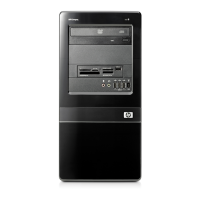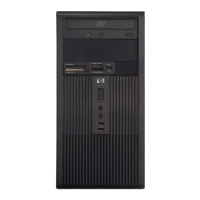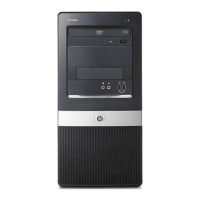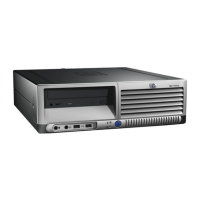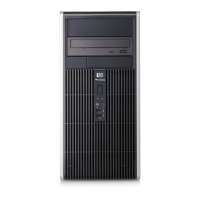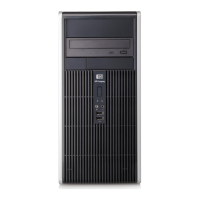Installing Additional Memory
The computer comes with double data rate 2 synchronous dynamic random access memory (DDR2-
SDRAM) dual inline memory modules (DIMMs).
DIMMs
The memory sockets on the system board can be populated with up to four industry-standard DIMMs.
These memory sockets are populated with at least one preinstalled DIMM. The sockets are labeled
DIMM1, DIMM2, DIMM3, and DIMM4. To achieve the maximum memory support, you can populate the
system board with up to 4GB (4 x 1GB) of memory.
DDR2-SDRAM DIMMs
For proper system operation, the DDR2-SDRAM DIMMs must be:
●
industry-standard 240-pin
●
unbuffered PC2-5300 667 MHz-compliant and unbuffered PC2-6400 800 MHz-compliant
●
1.8 volt DDR2-SDRAM DIMMs
The DDR2-SDRAM DIMMs must also:
●
support CAS latency 4 (CL = 4) for PC2-5300 667 MHz-compliant and PC2-6400 800 MHz
●
contain the mandatory JEDEC SPD information
In addition, the computer supports:
●
256Mbit, 512Mbit, and 1Gbit non-ECC memory technologies
●
single-sided and double-sided DIMMs
●
DIMMs constructed with x8 and x16 DDR devices; DIMMs constructed with x4 SDRAM are not
supported
NOTE: The system will not start if you install unsupported DIMMs.
Installing DIMMs
CAUTION: You must disconnect the power cord and wait approximately 30 seconds for the power to
drain before adding or removing memory modules. Regardless of the power-on state, voltage is always
supplied to the memory modules as long as the computer is plugged into an active AC outlet. Adding
or removing memory modules while voltage is present may cause irreparable damage to the memory
modules or system board. If you see an LED light on the system board, voltage is still present.
The memory module sockets have gold-plated metal contacts. When upgrading the memory, it is
important to use memory modules with gold-plated metal contacts to prevent corrosion and/or oxidation
resulting from having incompatible metals in contact with each other.
Static electricity can damage the electronic components of the computer or optional cards. Before
beginning these procedures, ensure that you are discharged of static electricity by briefly touching a
grounded metal object.
When handling a memory module, be careful not to touch any of the contacts. Doing so may damage
the module.
1. Remove/disengage any security devices that prohibit opening the computer.
2. Remove all removable media, such as diskettes or compact discs, from the computer.
ENWW Installing Additional Memory 9
